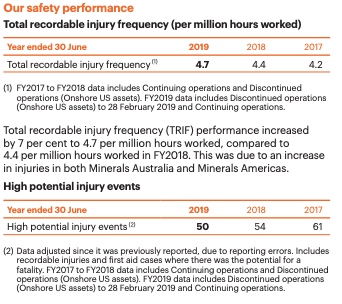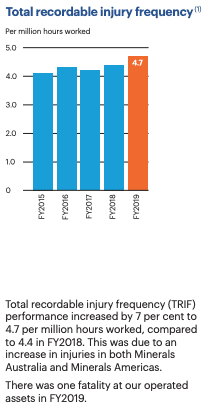BHP has released its’ annual report today. There’s some good safety news and some bad from BHP. While it only recorded one direct fatality across its’ operations, the most notable is the increase in total recordable injury (up to 4.7 per million manhours) across its operations.
Here’s what it says about key safety issues across the organisation (Extract from BHP Annual Report 2019)
On the death of Allan Houston…
Allan Houston suffered fatal injuries while he was operating a dozer at BHP Mitsubishi Alliance’s Saraji Mine. After a thorough investigation, we could not determine the direct cause of the incident. However, we identified several areas for improvement and are actively sharing the learnings from the investigation throughout our operations, with contract partners and the broader resources industry.
On the runaway train…
On 5 November 2018, Western Australia Iron Ore (WAIO) experienced a train rollaway event. There were no injuries as our team at Train Control intentionally derailed the train at a time when it was considered the safest to do so. Post the incident and before rail operations recommenced, we implemented additional procedures to help prevent a similar event from re-occurring.
On the management of contractors…
In FY2019, we established new requirements for engaging and managing contractors. The contractor safety requirements were rolled out across BHP and assurance programs have been established to monitor and verify the implementation of the requirements.
Safety leadership and culture
To strengthen our safety leadership and culture, we are educating our people about chronic unease, that is, being mindful of the possibility of what could go wrong, and creating a culture where it is safe to speak up and report hazards and incidents.
One of the objectives of our global Field Leadership Program is to strengthen the reporting culture. We monitor reporting culture across all our operations and we coach and support our leaders to improve the quality of our field leadership activities with our employees and contractors.
New events program
“We also introduced a new event management system for recording health, safety, environmental and community events. The system is designed to capture, analyse and track events in real-time and will be implemented in FY2020.”
On safety performance

On worker health….
Our goal is to protect the health and wellbeing of our workforce from potential occupational injury, now and into the future. We set minimum mandatory controls to identify and manage health risks for our employees and contractors. Our workplace health risks include occupational exposures to noise, silica, diesel particulate matter (DPM), coal mine dust, musculoskeletal stressors and mental health impacts.
The effectiveness of our health controls is regularly reviewed and subjected to periodic audit to verify the controls are implemented and operating as designed. Our periodic medical surveillance programs help us support early identification of potential occupational exposure illness and enable us to assist our people through illness management and recovery.
In FY2019, we established key performance indicators that require a 90 per cent adherence to schedule for health surveillance activities, achieving 79 to 100 per cent across the Group. We also reviewed our medical testing programs through internal and external benchmarking with industry peers and standards. Improvement opportunities identified from the review are expected to be evaluated and the implementation of endorsed recommendations are expected to commence in FY2020, along with plans to further increase adherence to planned surveillance activities.
Occupational illness
The incidence of employee occupational illness in FY2019 was 4.38 per million hours worked, an increase of 5 per cent compared with FY2018. The reported incidence of contractor occupational illness was 1.62 per million hours worked, a decrease of 16 per cent compared with FY2018. The overall decrease in contractor illnesses was predominantly driven by the 23 per cent increase in hours worked in FY2019. We do not have full oversight of the incidence of contractor noise-induced hearing loss (NIHL) cases in many parts of BHP due to regulatory regimes and limited access to data.

We continue to work with our contractors and regulatory agencies to resolve these issues. The majority of our reported occupational illnesses are musculoskeletal illness.
The improved identification and more effective control of causes of musculoskeletal stressors will be supported by the progressive implementation of the Standardised Work program. Standardised Work is a key foundational tool of the BHP Operating System that seeks to empower individuals to design work in a way that supports efficiency and ergonomics where health and other risks are identified, and enables additional controls to be identified and incorporated.

Our continued focus on implementing our requirements for fit testing for hearing protection devices has supported a 6.7 per cent reduction in the NIHL illness rate. We have seen an increase in the number of other illnesses reported, which include short-term, low-impact conditions such as blisters, skin conditions (dermatitis/eczema), bites and stings, due to a small increase in cases across most Minerals Australia operations.
As at 30 June 2019, 10 cases of coal mine dust lung diseases (CMDLD(4)) among our current employees were reported to the Queensland Department of Natural Resources, Mines and Energy. We continue to provide counselling, medical support and redeployment options (where relevant) for all 10 colleagues (seven of the 10 have been able to continue working).
Dermatitis/eczema cases arose from different work locations across
Olympic Dam and could be attributed to the continued education campaign on the prevention and management of skin conditions, which encourages early reporting of signs and symptoms. To a lesser extent, the increase was also driven by increases in mental stress conditions and heat stress cases at Olympic Dam in South Australia. These conditions are currently captured as ‘other illnesses’ but, with our strong focus on mental health, we plan to establish a stand-alone category for ‘mental stress conditions’ in FY2020. Across the Group, mental stress conditions continue to be reported in low numbers and the number of cases were not significantly different to FY2018.
Through the BHP Mental Health Framework, we continue to seek to foster a work environment where our people feel comfortable to raise their experience of mental stress and to access appropriate support when needed.
Occupational exposures
We set internally specified occupational exposure limits (OELs) to manage exposures to DPM, silica, coal mine dust and other potentially harmful agents. For our most material exposures, our process to set those OELs involves periodic monitoring and evaluation of scientific literature, benchmarking against peers as well as engagement with regulators, OEL-setting agencies and expert independent advice. Our approach to monitor and review our internal OELs is designed to ensure they continue to be aligned with or are more conservative than applicable regulated health limits.
For our most material exposures to DPM, silica and coal mine dust, we have committed to a five-year target to achieve a 50 per cent reduction in the number of workers potentially exposed(1) as compared to our baseline exposure profile (as at 30 June 2017(2)) by 30 June 2022.
In Petroleum, the divestment of our Onshore US assets during FY2019 changed the exposure profile for the region as workplace exposures to silica and DPM are no longer present. Our baseline exposure profile for the Group for the five-year target was therefore adjusted to remove the baseline exposures attributed to the Onshore US assets.
In FY2019, planned exposure reduction projects were implemented
across the Group, involving a collaborative effort from operational
and maintenance teams, supported by the Health, Safety and Environment, and Supply and Technology teams. Many assets exceeded planned exposure reductions resulting in an overall reduction of 49 per cent(3) compared to the revised FY2017 baseline. Planned growth projects across the Group may result in an increase in some potential exposures over the short term; however, commitments to achieve planned exposure reductions over the five-year target period remain unchanged.
On Coal mine dust lung diseases…
As at 30 June 2019, 10 cases of coal mine dust lung diseases (CMDLD(4)) among our current employees were reported to the Queensland Department of Natural Resources, Mines and Energy. We continue to provide counselling, medical support and redeployment options (where relevant) for all 10 colleagues (seven of the 10 have been able to continue working).
During FY2019, one former BHP employee had a worker’s compensation claim accepted for CMDLD resulting in a total, as at 30 June 2019, of six former workers diagnosed with CMDLD since January 2016 (noting that no Australian coal mine worker had been diagnosed with CMDLD in the preceding two decades). In addition to these confirmed cases, as at 30 June 2019, there were six intimated worker’s compensation claims for CMDLD from current and former employees that had not yet been determined.
READ RELATED CONTENT
- Coal mine workers protest in support of mine dust diseases victims group(Opens in a new browser tab)
- Dusts diseases register a first for Australia(Opens in a new browser tab)
Our Charter values guide our response and the support we offer, and we
are actively reviewing how we can improve timeframes and
processes for the determination of claims.
To further protect the health of our people we remain committed to:
• a reduction in our coal mine dust OEL from 2 mg/m3
to 1.5 mg/m3 to be achieved as soon as reasonably practicable and no
later than 1 July 2020 (as compared with the regulatory OEL of
2.5 mg/m3), noting that all operations have developed exposure
reduction plans;
• a reduction in potential exposure to silica in coal mine workers
that exceeds a level 50 per cent lower than the current regulatory
level by no later than 1 July 2021.
Image: BHP
You can view the full BHP annual report here
READ MORE MINING SAFETY NEWS














Add Comment